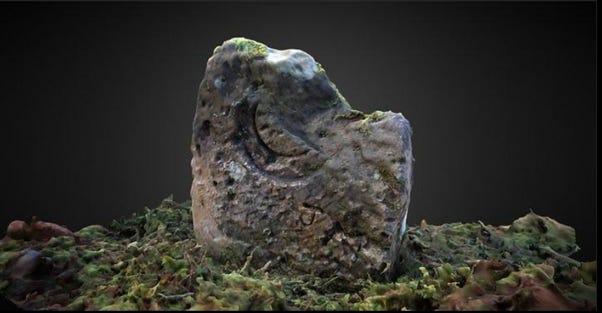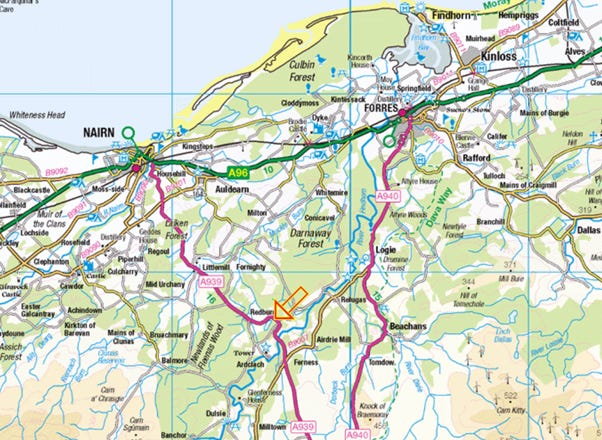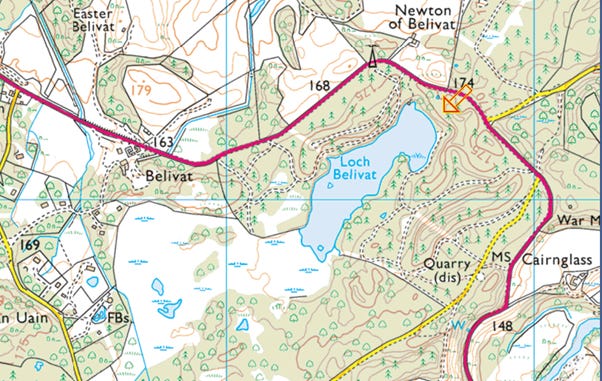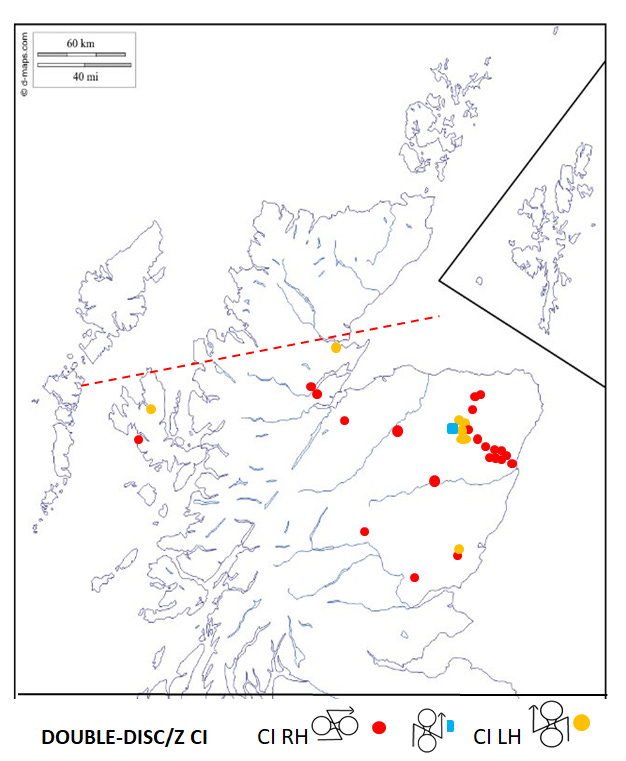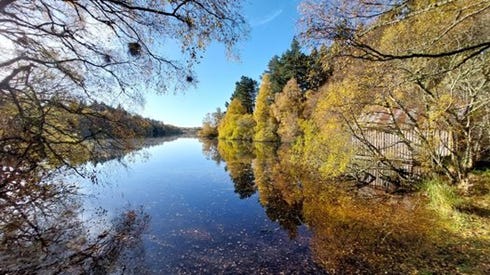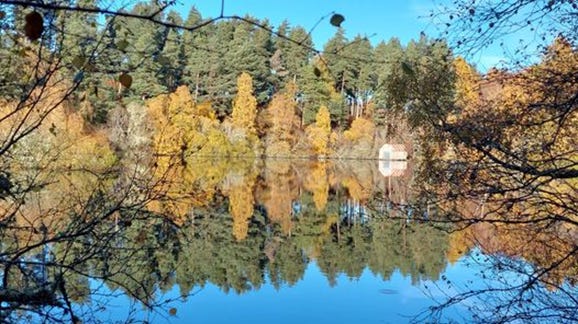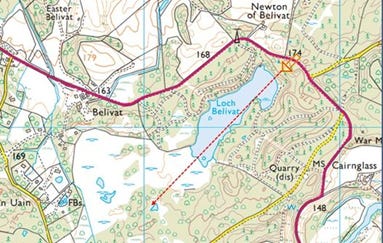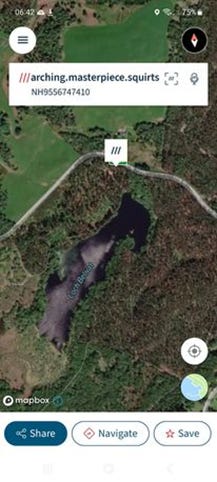Discovering a possible Pictish symbol stone at Loch Belivat
Something exciting, and puzzling, happened the other day. Douglas Ledingham had been busy lately taking images of various ancient stones, including Pictish symbol stones. So perhaps he was attuned to seeing stones with symbols, but he was still surprised to come across a stone, about half a metre high, at the northern end of Loch Belivat, a stone with its top broken off, but still showing two concentric circles – what was this? Was this a possible symbol stone?
(This article is indebted to the members of the facebook group Pictish symbols: Art and Context who took part in a discussion on Douglas’ find, and especially to Douglas who brought this find and photos and questions to us.)
The stone has no entry on Canmore. But it was first reported in 2000, and a note in a Highland Historic Environment Record MHG29237 says 'Inscribed Stone (Pictish to Early Medieval - 300 AD? to 1057 AD?)’. But the location was slightly off (since corrected, thanks Tim Blackie), the find spot is at NH95701 47282. Modern graffiti JM is under the circles. Douglas’ 3D scan can be seen here.
The location of this stone is curious. There aren’t all that many Class I symbol stones in this part of Moray, the nearest being a fragment found at Forres. And most stones come from somewhere known as a settlement spot, or close by. Loch Belivat however is in wilder parts further from the coast, although it’s possible that an older Pictish path passed around the head of the loch to Nairn, much as the modern road today does. So what would a symbol stone be doing out here at Loch Belivat?
Is this really a symbol stone?
If this is a symbol stone then we seem to only have a fragment of the bottom half, but its full size would have been similar to many other early symbol stones. What is left of its surface is quite eroded but it doesn’t seem to have a nicely prepared and smoothed surface, an indication that this would be a very early Class I stone, perhaps from as early as the first or second centuries AD.
But the main concern is that the circles appear to be quite deeply carved into the stone, you can see this when turning Douglas’ scan to the side. I can’t recall having seen a symbol carved as deeply as this, but given that this would be a very early stone on an unprepared surface, I’m not sure this rules it out as a true symbol. (Although to be honest I haven’t kept my eye on this sort of thing either, so perhaps there are other stones like this.)
If not part of a symbol, it’s hard to imagine anything else these two concentric circles could possibly be. Could it be some strange modern artefact? the smoothly eroded state of the top of the stone seems to negate that possibility, for if the circles were part of something relatively modern that had subsequently been broken off, I’d expect the edges to be sharper and far less eroded.
What symbol might we be looking at?
There are only two possible candidate symbols, the first is a double-disc +/- Zrod, the second is a cauldron.
First, let’s rule out the double-disc symbol. This usually occurs in good settlement locations with agricultural lands around. The double-disc/Z likely represents the two stones of a quern with the Z rod being a head of grain. It would be quite unusual to find a double-disc/Z symbol in a wilder region like the woods surrounding Loch Belivat.
There are otherwise no Class I double-disc symbols in the Moray coastal region, although we do have a few on later Class II stones – at Elgin, Brodie, and Glenferness. Still, this location seems out of the way and inappropriate for a double-disc symbol.
The inner circles of a disc of the double-disc symbol tend to be pushed further to the centre, again making it unlikely to be this symbol, although not impossible. Here is the Belivat stone compared to Aberlemno1 and Dyce1.
The Belivat circles are unlikely then to be part of a double-disc symbol, because the rings are unusually spaced, because the Moray coastal region does not feature this symbol on Class I stones, and because the stone is in a wilderness location outside main agricultural locations where the double-disc is usually found.
So let’s look at the cauldron symbol. Here we do find a number of cauldron symbols with an internal circle not far from the outer circle, as we see on the Belivat stone.
But, most telling of all, the Belivat stone sits overlooking a lovely lake, and this where we find stones with a cauldron symbol in other places too, for example, Lindores beside Lindores Loch, and Glamis beside the Loch of Forfar. The cauldron is still used to this day to describe a lake or round valley.
The cauldron symbol is less frequent than the double-disc/Z symbol, and it has a wide and fairly even distribution across Pictland, unlike the double-disc/Z symbol which shows a focus in certain areas. This time, the location of the Belivat stone with a possible cauldron symbol feels appropriate.
The question of whether the two circles could be part of a mirror symbol was raised. Mirrors do sometimes have two concentric circles as a form of border, but a Class I mirror below two lost symbols would be expected to have a handle pointing down, which this Belivat stone doesn’t have. Therefore we can rule out a mirror.
The Loch of Belivat
So far, we have the distinct possibility that this stone is a very early Class I symbol stone with its lower symbol a cauldron. But the question then is, what is so special about this Loch of Belivat that it warrants a cauldron symbol?
The first thing to say is that this small lake, surrounded by woodland, is very beautiful. And that too is something typical of many symbol stone locations. Someone once said that looking for symbol stones is like being taken by the Picts on a magical tour of the most beautiful places in the land.
The name Belivat is thought by W.J. Watson (The Celtic Place Names of Scotland, p444) to represent buail-fhiodhaid 'fold of saplings', or thicket-fold. He then says that the saplings here are likely hazel, but doesn't explain why.
The lake however is very special. It sits sheltered below a terminal moraine, its waters like a mirror. It’s not large, at 25 acres in size. But it is spring fed, not fed by flowing streams, and because of this, fish are unable to migrate into its waters.
This odd lake basically is a giant spring or well, and it reminds me of many other places in the Celtic world where water is doing something odd or unusual, places that the Celts love to mark as special. My own favourite is at the monastery of St Fechin at Fore in Ireland, where the water from a nearby lake runs invisibly all the way under a hill and abruptly comes out in the valley of Fore as a gushing spring. Another spectacular site a bit reminiscent of this lake at Belivat is the massive nemeton with multiple Gaulish and Roman shrines at Villards-d'Héria in France, where two lakes are invisibly joined by the water flowing underground, so that there is no stream above ground feeding the land-locked lakes.
You can see some more photos of Loch Belivat here.
A winter solstice alignment?
This stone sits at the northern end of the lake, on a rise overlooking the length of the lake towards the south-west. It may be that the reason the Picts chose this spot on the lake is an alignment with the setting winter solstice sun.
It’s wonderful to imagine this scenario, midwinter, the mirrored lake frozen, bound in by ice and snow, magical, with the midwinter sun slowly sinking into the far end of the lake.
Directions
For the curious wanting to see this stone for themselves. The easiest place to park is at NH9556747410. The stone can be found by following the top of the moraine to the right of the road along a small deer track.




